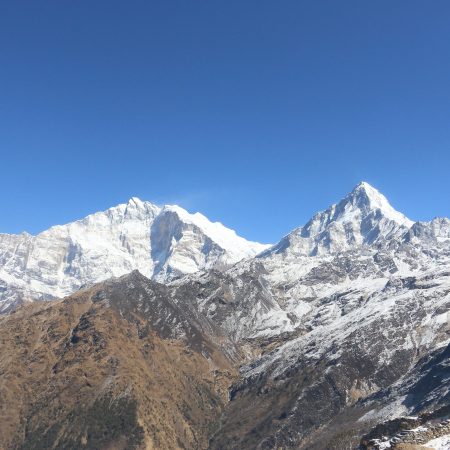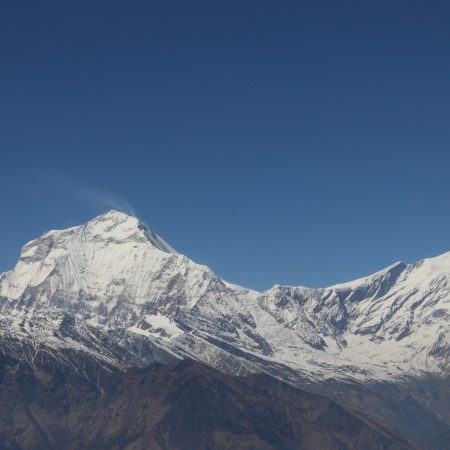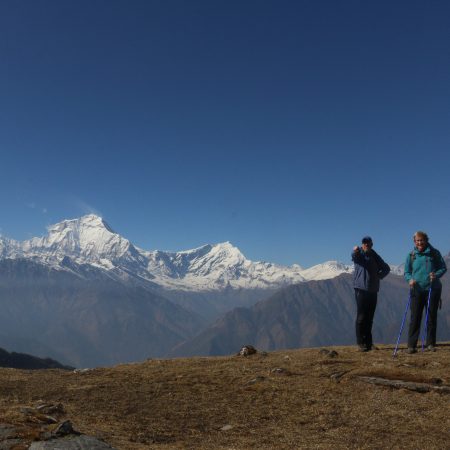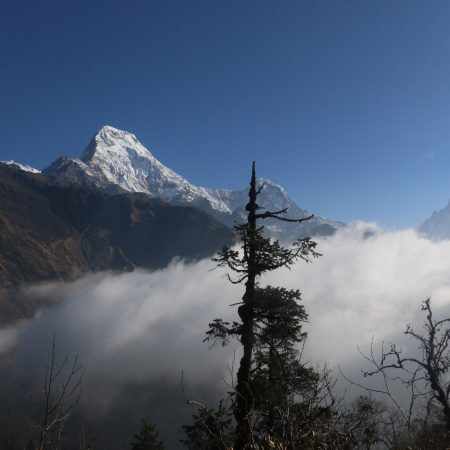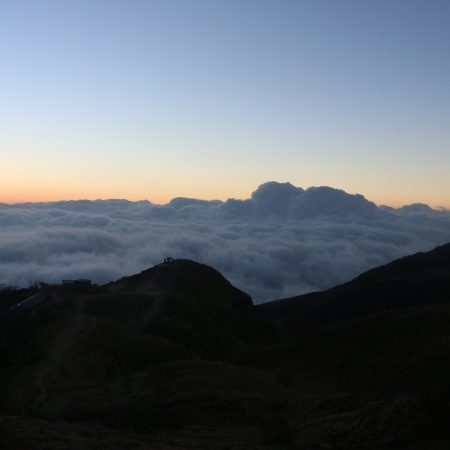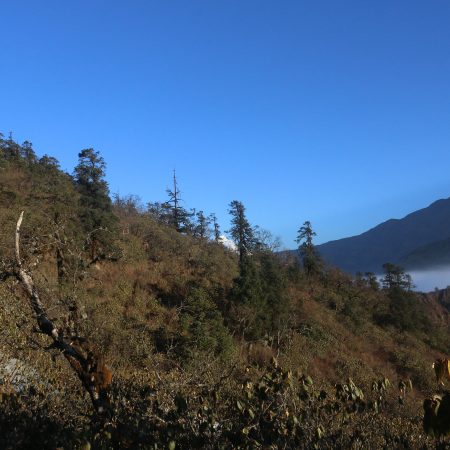7 days
3660 m
5 days
Pokhara/Pokhara
Trip Overview
Khopra trek also known as khopra ridge trek lies between Annapuran and Dhaulagiri region of Nepal. From Khopra trek view point, we can see the magnificent view of Mt.Annapurna, Mt.Dhaulagiri, Fishtail, Nilgiri Himal and other important mountains very closely.
It is also the gateway to one of the world’s highest lake of the world – Khayer Lake (4660 m) which lies in the foothill of Annapurna south that takes 1 day extra. During the spring season (March-April), we can walk through the beautiful rhododendron forest, also can see blossom of magnolia, orchids and other wild flowers. This trek is also famous for rare sighting of rare birds, Daphne (national bird of Nepal), and other small wild animals too. Breath – taking mountain views, crossing through the ethical village reside by magar, gurung, Brahmins, chhetris, damai, kami who are boosting the village’s development living in a harmony. The main earning of this village is agriculture and tourism. While trekking through this village, we will be staying in a community run home stay whose profit will be use in the boosting of the community development like investing in a community schools, health and other developmental programs.
Trip Itinerary
1.5 hrs of driving to the Nayapul (gateway to Khopra trek), and trek will start on the dirt road via Birethanti until Hile of 3 hrs of walk and we will do our lunch and another 2 more hour straight uphill of stone stairs up to Ulleri where we will stay overnight.
Next day, early in the morning after your breakfast, we will start ascending steep and gradual footsteps following the Banthanti village, and through the jungle of about 4 hours until Ghorepani where we will stop for our short break for lunch. Follow the downhill via Chitre, trail takes you to the end of this village in approx. of 1.5 hours. The last 30 min of climb will brings you in a beautiful mahar village called Swanta.
Trail goes through the rice field and gentle climb through the forest to Phedi of about 2.5 hrs. Path ascends from here for another 2.5 hrs up to chitsibang where chances to see rare birds and small wild animals. (We will stop at Phedi for lunch if the lunch point is open, otherwise we will do packed lunch).
3 hrs of uphill trek of mix vegetation (half of the trek through rhododendron forest and half through a barren land) up to Khopra danda. After lunch, to see more interesting landscapes, vegetation and better view, we will walk up about 300-400 meter from Khopra danda in the free time of the afternoon. Khopra danda is famous for magnificent view of Mt.Dhaulagiri, Annapurna south, Nilgiri and Mt.Fishtail.
Downs and ups will bring you to Bayalikharka via chitsibung after trekking of about 4 hrs. We will stop here for lunch and another 2 hrs of gentle walk will bring you at another beautiful place called Dobato from where we also can see magnificent Mountain View.
Early in the morning for the sunrise view, we will walk up to Muldai for 40 min, from where we will be sighting the Mt.Dhaulagiri, Annapurna south, Mt.Fishtail and other mountains which have better view than Poonhill. After breakfast, we will leave for Ghandruk (beautiful gurung settlement) which takes 6 hours of all downhill via Tadapani. The place Tadapani stops for Lunch and continue walk downhill to Ghandruk.
Early in the morning, after your breakfast at your hotel, we will start hiking descend, mostly downhill and some part with dirt road, you will back to junction place, birethanti by passing through several small villages and rice field of about 4.5 hrs and stop for lunch at Birethanti. Another 30 min continue to Nayapul where your jeep will pick up and again 1.5 hrs drive back to Pokhara and transfer to your rest point.
Important Information
Include: -
- All Private transport
- Guide for Trek
- Porters
- Meals
- Tea house Accommodation,
- All permits
Exclude: -
- Travel Insurance
- Tipping
- Personal equipment
Cost:
USD 730 per person
Single supplementary: USD 100
Important Information
Trekking season in Nepal: The usual trekking season starts from September to May. During the remainder of the year, Monsoon makes travelling difficult due to wet areas and offers little in the way of mountain views. Some treks that cross high passes are better attempted in months other than December and January because of the heavy snowfall in some parts of the country. The temperature rises considerably under altitudes of 3000 ft. in April and May in some parts of the country, therefore it is wise to plan accordingly.
Teahouses in mountain: Teahouses are in the mountains where you will be staying are simple yet hospitable with good enough food and stunning views. Compare to city area teahouses are very basic but after 5-6 hours walking in the mountain you will relish the comfort. Most of these lodges have 08-to 12 room can sleep 15 to 20 people, with good food and fairly high hygiene levels. The basics of conversation and ecology are now being practiced with some success.
Guide and Porters: All guides who work with Skylark Himalayan have considerable local experience. The guide concern is his group’s welfare, health, safety and he aims to ensure you are relaxed while providing the best possible food and accommodation. And he’ll also strive to earn your friendship and will be keen for you to come to know and love Nepal.
And all the guides who work with Skylark Himalayan have guiding license from Nepal government, basic first aid training from red cross Nepal, wilderness training from SOLO outdoor school (locally known Initiative Outdoor), Child protection training and others.
Most porter come from rural areas and a farmers for 6 to 7 months of the year. These porter work hard and with care and have aims to progress into guides. Typically they live hard and frugal lives and they are used to carrying heavy loads.
Meals-Food on mountain region of Nepal,
A large variety of food is found in the mountain region during trek. Even our clients say there is better food in mountain than in hotels of city. The food variations are defendant on the culture and region background but the tea-house have a menu and they do have varieties of food. Some common day meal is follow:
Breakfast
Porridge, eggs any style-usually scrambled, boiled or fried eggs, toast local bread (Gurung bread), chapatti (Indian flat bread), honey or peanut butter, organic fresh tea, coffee and many more.
Lunch
In many regions, the chief will provide a simple common hot meal in lunch. That could be potatoes, noodles, curry, salad, rice and lentil, fresh meat, vegetables and fruits. Sometimes when walking through high passes, there will be a packed lunch which may consist of common packed able lunch like bread with jam and honey, sandwich, boiled eggs, fruits, chocolates, bottle of juice. While arriving to teahouses there will be tea, coffee.
Dinner
With basic equipment they manage to make excellent cake, apple tarts, pizzas, fried potatoes, chips, spaghetti, pasta. Chefs in tea-houses are well trained in producing a variety of food and almost always ready to serve the food of specific request.
While trekking in Nepal our chefs, and assistant guide are well trained to serve and take order of the food in hygienically way. Vegetarian and vegan meals are easily catered for.
Transportation: Skylark Himalayan using a best transport company for our clients. Before departing on a trip, we using vehicle, we always check insurance of vehicle, good condition of vehicle (seatbelt, seat, wheel, looking glass, all windows etc.), Driver (driver attitude, make sure drunk or not, smartness, driving speed etc.)
Insurance: As strongly recommended by Skylark Himalayan Travel to the clients agree to effect what they consider to be adequate Travel Insurance to cover their person and their personal effects for duration of the tours, Trekking, Rafting or any of activities in Nepal
Health and Safety: Fundamentally we have experienced staffs that have been trained in how to look after clients safely, and what to do in the event of an emergency. Almost all the company’s staffs are experienced, all leaders have done advanced first-aid training from Initiative Outdoor school, Nepal (authorized by SOLO WILDERNESS MEDCINE SCHOOL), Child Protection training, and they are well aware of the high standards that we want in maintain. We also have strong relationships with local communities, health care facilities
Responsible Travel: Skylark Himalayan completely follow tall rules, regulation and code of Nepal responsible trek organizer of responsible tourism. Responsible tourism is an action based on a sustainable idea. We work under eco friendly environment and we want you to follow and help to save the environment. Skylark Himalayan are keen to preserve and protect the historical places and mountain to show the value of those things to coming generation.
Skylark Himalayan Travel are always aware to operate tours, trekking and other activities in eco- touristic destination to preserve natural and cultural heritages. Skylark Himalayan always aim to make extensive use of the local available products to help local communities. Skylark Himalayan staffs and guides are also employed from local communities, which helps more authentic experience for travellers. We believe that all the staffs including guide, porter, Sherpa are the back bone of organization so its our responsibility to make them happy by providing protections insurance, good salary and outdoor gear. So that, they are happy to serve good service. Without them organization can't serve the costumer need.
TREKKING SUGGESTED EQUIPMENT
(Up to 4,000 m.)
1 Pair strong mountain / hiking boots (well worn-in and with ankle support)
1 Small daypack
* 1 Sleeping bag (comfortable to -10C)
* 1 Down jacket / all weather Anorak
1 Light water & windproof jacket
2 - 1-litre water bottles
1 Inner sleeping sheet (?)
1 Torch / flashlight & spare batteries
1 Medium sized travel towel (quick drying)
1 Washing kit: include Personal toiletries
Talcum powder, Blister plasters, Toilet paper
Bio degradable soap / shampoo
Anti-bacterial gel for 'washing' hands
First-Aid kit (please make sure it is trek and wilderness specific) and any personal medication
1 Pair sport shoes/sandals (for the time off the trek)
2 Pairs lightweight trousers
2 Pair shorts
1 Fleece / warm sweater
1 Sweatshirt / light sweater
2 T-Shirts
2 Long sleeve cotton (or polypropylene) shirts
3 Pairs heavy wool socks
2 Pairs light socks
Walking poles
Underwear (including thermals)
Cotton Headscarf / bandanna
Sunglasses (with side shields and UV protective lenses) and sunhat
Sunscreen Lotion (30-50 SPF), Money belt (?)
Warm hat and gloves (preferably waterproof)
3 to 4 Plastic bags (for wrapping clothes)
Water purification tablets/ solutions (preferably iodine)
Insect repellant
Adapter plug (for charging camera batteries and other electronic devices)

